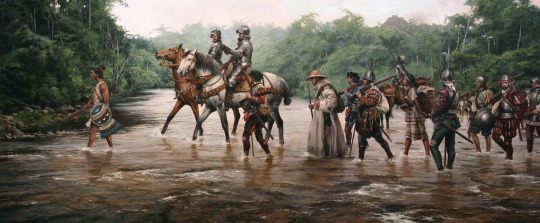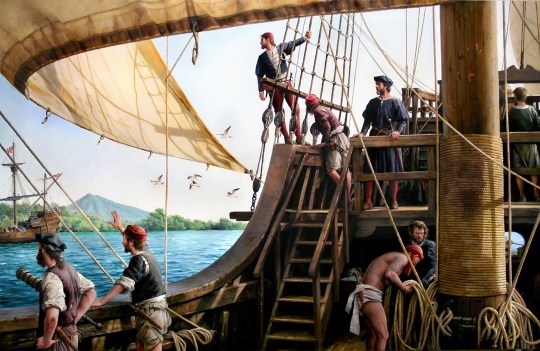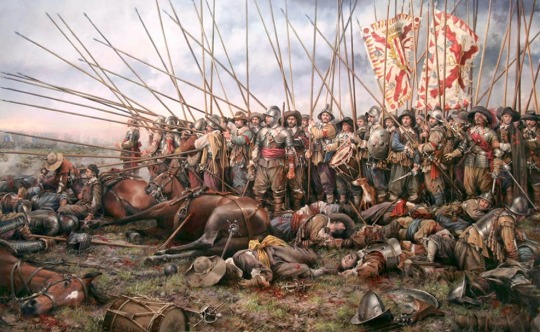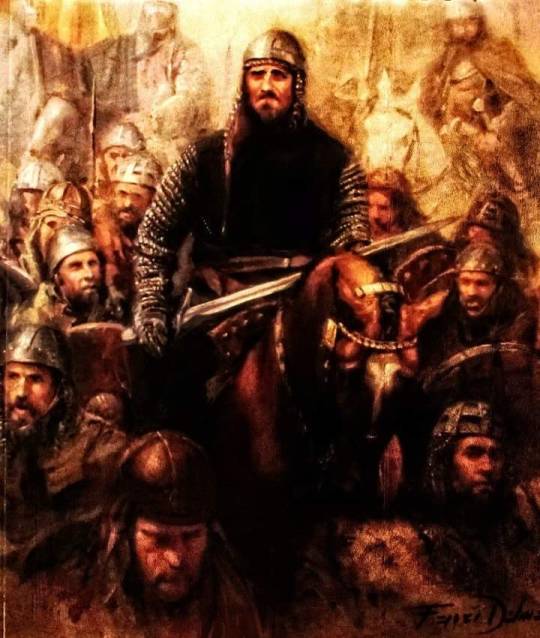#augusto ferrer dalmau
Text

The March to Tenochtitlan by Augusto Ferrer-Dalmau
#hernán cortés#conquistador#art#augusto ferrer dalmau#conquistadors#tenochtitlan#tenochtitlán#mexico#spanish#spain#aztec#aztecs#mexica#mesoamerica#bartolomé de olmedo#pedro de alvarado#americas#history#european#age of discovery#age of exploration#explorer#spanish empire#conquest#aztec empire#expedition#river#friar#knight#priest
83 notes
·
View notes
Text
instagram
#Augusto Ferrer Dalmau#Ferrer Dalmau#Hispanidad#España#Spanish painters are the best#Hispanic#History#Instagram
0 notes
Text

Augusto Ferrer-Dalmau painting Rocroi, el Último Tercio (Rocroi, the Last Tercio) (2011)
83 notes
·
View notes
Text

546x650 "Guardia Civil 1920", cuadro de Augusto Ferrer-Dalmau Nieto. España Nacional.
#spain#españa#spanish#español#espana#espanol#ferrer dalmau painter#augusto ferrer dalmau nieto#spanish civil guard#guardia civil#national spain
7 notes
·
View notes
Text
Los «Cuentos del vivac» de Federico Urrecha: relatos ambientados en las guerras carlistas (3)
Los «Cuentos del vivac» de Federico Urrecha: relatos ambientados en las guerras carlistas (3)
Otros dos relatos que guardan cierta semejanza entre sí son «Los pelones» y «La cuña». Si hasta ahora hemos encontrado héroes individuales, aquí el protagonista es colectivo, pues se trata de sendos grupos de soldados. El primer relato, dedicado a Sinesio Delgado, insiste en el narrador testigo: «Si yo me acabara sin contaros la verdad de lo que pasó en Hormigosa el 12 de Junio, me llevaría…

View On WordPress
#Augusto Ferrer-Dalmau#Cuento español del siglo XIX#Cuentos del vivac#El ascenso de Regojo#Escritores navarros#Federico Urrecha#Guerras carlistas#Húsares de la Princesa#HILINA#Historia literaria de Navarra#Historia y literatura#La cuña#Los pelones#Narrativa del siglo XIX
1 note
·
View note
Text

1521 12 21 Primus Circumdedisti Me - Augusto Ferrer Dalmau
Juan Sebastián de Elcano se pone al mando de la nao Victoria y pone rumbo desde Tidore (isla ubicada en el Mar de las Molucas, en la actual Indonesia) hacia España atravesando el Pacífico hacia la costa africana, intentando dar la primera vuelta al mundo, mientras otra de las embarcaciones de la expedición española daba la vuelta e intentaba regresar por América.
29 notes
·
View notes
Text

"Mi bandera" de Augusto Ferrer-Dalmau rememora al granadero Martín Álvarez en la batalla del Cabo de San Vicente (14 de febrero de 1797).
Defendió la bandera de su navío, el San Nicolás de Bari, frente a los ingleses cuando la tripulación estaba muy mermada y los pocos supervivientes malheridos.
Según la crónica de un oficial inglés testigo de la batalla del Cabo de San Vicente, ocurrida en 1797:
«[...] En el barco español San Nicolás de Bari queda algo por conquistar. Sobre la toldilla, arbola la bandera española, cual si todavía el barco no se hubiese rendido. Un oficial inglés que lo observa, va a ella para arriar la bandera. Antes de llegar, un soldado español, de centinela en aquel lugar, sin apartarse de su puesto le da el alto. El oficial no le hace caso y se acerca, el sable del centinela lo atraviesa con tal fuerza que lo queda clavado en la madera de un mamparo.
[...] Un nuevo oficial y soldados se acercan y el centinela no logrando desasir su sable de donde se hallaba pinchado, coge el fusil a modo de maza y con él da muerte a otro oficial y hiere a dos soldados. Da después un salto desde la toldilla para caer sobre el alcázar de popa, donde lo acribillan a tiros los ingleses. Nelson, que ha presenciado la escena, se aproxima al cadáver silencioso y ordena que se le envuelva en la bandera que había defendido con tanto ardor».
Pero el centinela Martín Álvarez no estaba muerto, sino muy mal herido. Nelson, valorando el arrojo y la determinación del soldado español, hizo que le llevaran a tierra para curar sus heridas, le desembarcaron en el Algarve portugués donde permaneció en un hospital hasta recuperarse y desde allí lo llevaron a España.
Autor: Augusto Ferrer-Dalmau.
Año: 2014.
14 notes
·
View notes
Text

Rocroi shattered the myth of invincibility of the Spanish Tercios, the terrifying infantry units that had dominated European battlefields for the previous 120 years. The battle is therefore often considered to mark the end of Spanish military greatness and the beginning of French hegemony in Europe during the 17th century…
Please follow link for full post
Augusto Ferrer Dalmau,War,Rocroi,Zaidan, biography, Arthistory, Paintings, Artists, History, footnotes, fineart, war casualties,
01 Painting, The art of War, Rocroi, the last third, by Augusto Ferrer-Dalmau, with footnotes
4 notes
·
View notes
Photo

Cervantes at the battle of Lepanto, by Augusto Ferrer-Dalmau.
31 notes
·
View notes
Text

The Battle of Rocroi "Rocroi, the Last Tercio" by Augusto Ferrer-Dalmau
#augusto ferrer dalmau#battle of rocroi#art#thirty years war#rocroi#tercios#tercio#spain#spanish empire#spanish#pikemen#infantry#pike and shot#europe#history#spanish golden age#habsburg spain#france#habsburg monarchy#house of habsburg#habsburg#european#battle#last stand#franco spanish war
66 notes
·
View notes
Photo

The Last Battle of el Glorioso, 17 October 1747, by Augusto Ferrer-Dalmau, 2014
The Spanish 74-gun ship Glorioso was on her way to Cadiz from Ferrol, where she had loaded treasures for the Spanish crown, when she was attacked by a number of English ships, including the Royal family squadron of privateers commanded by Commodore Walker on 17 October 1747. She was engaged by several ships of inferior force including Walker's privateer the King George, 32 guns, which kept up a close but unequal struggle for several hours, and the Dartmouth, 50 guns, which blew up. After a five-hour battle, the Glorioso was finally captured by the Russell, 80 guns, which was returning half-manned from the Mediterranean.
50 notes
·
View notes
Text
🇪🇸 («¡Despierta hierro!»)Uno de los gritos hispánicos más conocidos. Los almogávares, una infantería ligera al servicio de la Corona de Aragón durante la Reconquista, golpeaban sus espadas contra el suelo haciendo saltar chispas contra las piedras al grito de guerra: «Aur, aur... Desperta ferro» («escucha, escucha...Despierta, hierro»). Obra Augusto Ferrer-Dalmau.
VAMOS TARDE YA !!!

2 notes
·
View notes
Photo

'The Road of Cortés' by Augusto Ferrer-Dalmau via RealisticArmory
16 notes
·
View notes
Text


Happy 4th of July
Augusto Ferrer Dalmau, La marcha de Gálvez (top); Por España y por el Rey, Gálvez en América (bottom)
2 notes
·
View notes
Text
Αυγουστίνα της Αραγωνίας Η Ζαν ντΑρκ της Ισπανίας
Η Αυγουστίνα Ραϊμούνδα Μαρία Σαραγόσα ι Ντομένεκ (Agustina Raimunda Maria Saragossa i Domènech), γνωστή ως Αυγουστίνα της Αραγωνίας (Agustina de Aragón), (Ρέους, 4 Μαρτίου 1786 – Θέουτα, 29 Μαΐου 1857) ήταν Ισπανή ηρωίδα που πολέμησε στον Πόλεμο της Ιβηρικής Χερσονήσου, αρχικά ως πολίτης και αργότερα ως επαγγελματίας αξιωματικός του ισπανικού στρατού. Φωτογραφία: By Augusto Ferrer-Dalmau…
View On WordPress
0 notes
